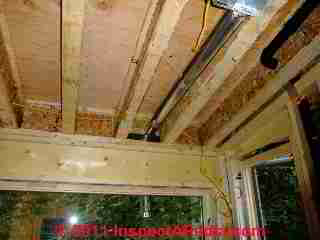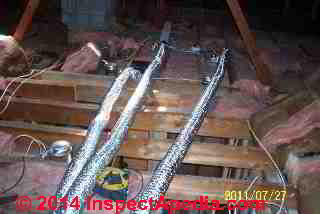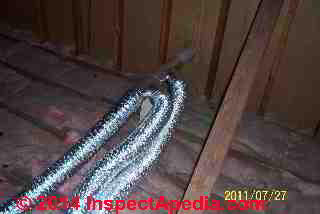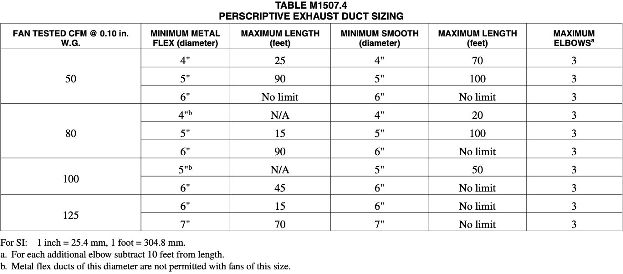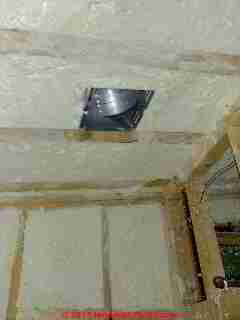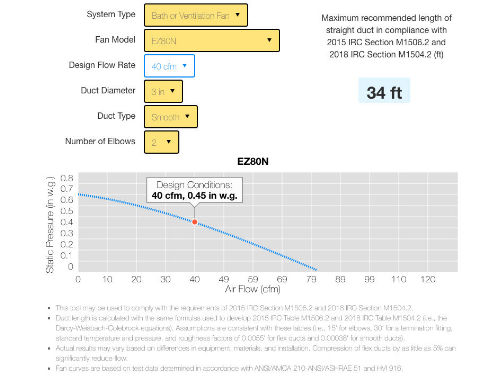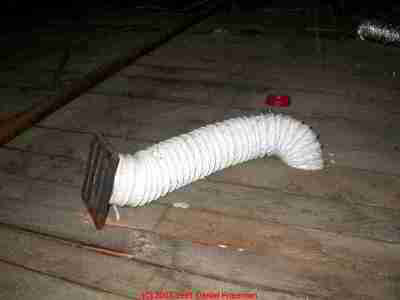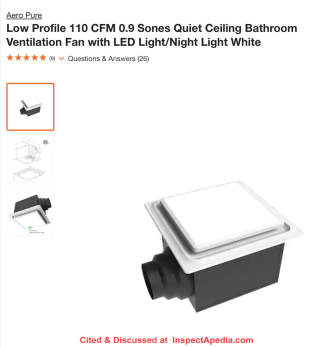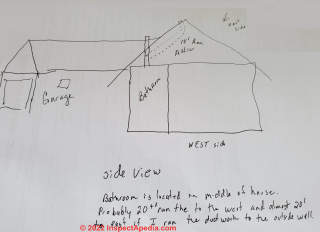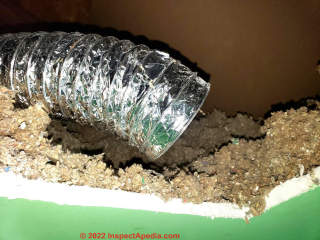 Bathroom Ventilation Fan Duct Lengths
Bathroom Ventilation Fan Duct Lengths
Maximum & minimum recommended lengths
- POST a QUESTION or COMMENT about bathroom vent fan and fan ducting installation procedures, codes, standards
Bathroom exhaust fan duct length specifications:
Here we provide specifications for recommended minimum & maximum duct lengths for bathroom vent fans. A bath vent fan duct that is too short may violate the manufacturer's installation instructions, may not work properly, or may be drafty; a bath vent fan duct that is too long may restrict air flow such that the fan is not functional.
This bath vent fan installation, troubleshooting, repair article series explains why bathroom vent fans are needed and describes good bath vent fan choices, necessary fan capacity, and good bath vent fan and vent-duct installation details.
InspectAPedia tolerates no conflicts of interest. We have no relationship with advertisers, products, or services discussed at this website.
- Daniel Friedman, Publisher/Editor/Author - See WHO ARE WE?
Bathroom Vent Fan Duct Length Guidelines & Specifications
Question: what is the maximum horizontal bath vent fan duct length through an attic?
You note for the best bath vent fan duct termination to route the duct: horizontally through the building wall at a building gable-end wall (first choice), or if the gable end is too distant ... . what is a distance the would be within you recommendation?
Reply: Bathroom Vent Fan Vent Ducting Installation Advice Details from InspectAPedia
Our bath vent fan duct installation photo shows use of solid metal 4" ductwork conducting the fan exhaust to an outdoor soffit under a cathedral ceiling roof.
Following the sloping roof/ceiling and exiting into the soffit, this fan vent duct slopes down away from the vent fan which you can just see in the photo upper right corner.
The ceiling cavity was later filled with solid foam insulation (second photo below).
Any condensate in the ductwork drips to outside - a possible winter icing worry, but because of the solid foam insulation there should be little condensation in the fan duct. Also we insulated the full outdoor soffit bay where the duct exits the building to avoid condensate icing.
Take a look at the vent fan installation manual for the particular bathroom vent you are installing.
Because bath and kitchen vent fans vary in their power, the length of the vent ducting could provide enough airflow resistance to a small vent fan that it would not work properly.
In our photographs above, courtesy of Galow Homes, three long, un insulated bathroom exhaust fan ducts cross the cold attic floor of a New York home and then join together at a common sidewall exit of the same diameter.
There is little chance that these bath vents will work effectively and a good chance of pooling condensate in the low spots of the duct run.
Table M1507.4 Prescriptive Exhaust Duct Sizing
[Click to enlarge any image]
Watch out: be sure to see the details of duct length limits given just below on this page. For higher CFM exhaust fans and for longer runs, you will need to use a larger-diameter exhaust duct than the 4-inch minimum.
Sources:
IRC RESIDENTIAL SPECIALTY CODE - CHAPTER 15 EXHAUST SYSTEMS 2017 FLORIDA [PDF] modeled from the International Residential Code or IRC
IRC RESIDENTIAL SPECIALTY CODE - CHAPTER 15 EXHAUST SYSTEMS 2011 OREGON [PDF] modeled from the International Residential Code or IRC
The bath vent fan installation manuals we reviewed did not specify a maximum exhaust duct length, they just say route the duct to the outdoors
. If you contact your bath vent fan manufacturer directly and speak with a technical support contact, s/he should be able to give you a maximum recommended exhaust duct length for their fan model.
We haven't yet found a bath vent fan manufacturer's spec nor building code or ASHRAE specification limiting the horizontal run length for bathroom vent fan ducting, perhaps because the normal size of residential buildings means that the duct run length will be within the operating capacity of currently-sold bath vent fans.
But we do have some specific suggestions for a good bath fan vent duct installation and some duct length specifics as well:
Maximum & Minimum Bath Exhaust Fan Duct Length
Maximum Bathroom Exhaust Duct Length
Watch out: there is no one right answer to "how long can I make my bath exhaust vent duct run?" is that ... it depends on
- The fan model (its size and CFM rating) or the required or "design" flow rate in CFM (from your local code, such as 60 or 80 CFM).
Watch out: Industry experts recommend 60 cfm to 80 cfm for small bathrooms and 200 to 300 cfm for a large bathroom with a steam generator. - The vent material (smooth vs. corrugated or worse)
- The vent diameter
- The number of elbows required along th vent duct path
- The installation instructions provided by the fan manufacturer. Note that the 2018 International Residential Code for One- and Two-Family Dwellings requires that
Vents must be installed according to the vent manufacturer. - The actual exhaust venting distance between the exhaust fan and the building exterior point of termination
The exhaust vent must comply with local codes that in turn are typically adopted versions of
The 2015 IRC Section M1506.2 or the 2018 IRC Section M1504.2 (ft)
So we need to know the Brand and model of the exhaust fan and then to look at that manufacturer's specific installation instructions (that will include duct length and length-equivalent numbers for each elbow or bend)
Code Table M 1506.2 Duct Length
The length of exhaust and supply ducts used with ventilating equipment shall not exceed the lengths determined in accordance with Table M1506.2.
Exception: Duct length shall not be limited where the duct system complies with the manufacturer's design criteria or where the flow rate of the installed ventilating equipment is verified by the installer or approved third party using a flow hood, flow grid or other airflow measuring device.
IRC Table M 1506.2 Duct Length |
||||||||||||||||
| Duct Type | Flex-Duct |
Smooth-Wall Duct |
||||||||||||||
| Fan Airflow Rating CFM a |
50 | 80 | 100 | 125 | 150 | 200 | 250 | 300 | 50 | 80 | 100 | 125 | 150 | 200 | 250 | 300 |
| Duct Diameter b in Inches |
Maximum Duct Length in Feet c d e |
|||||||||||||||
| 3 | X | X | X | X | X | X | X | X | 5 | X | X | X | X | X | X | X |
| 4 | 56 | 4 | X | X | X | X | X | X | 114 | 31 | 10 | X | X | X | X | X |
| 5 | NL | 81 | 42 | 16 | 2 | X | X | X | NL | 152 | 91 | 51 | 28 | 4 | X | X |
| 6 | NL | NL | 158 | 91 | 55 | 18 | 1 | X | NL | NL | NL | 168 | 112 | 53 | 25 | 9 |
| 7 | NL | NL | NL | NL | 161 | 78 | 40 | 19 | NL | NL | NL | NL | NL | 148 | 88 | 54 |
| 8 & Above | NL | NL | NL | NL | NL | 189 | 111 | 69 | NL | NL | NL | NL | NL | NL | 198 | 133 |
Notes to the table above:
Adapted from IRC Code Table M 1506.2 Duct Length [image file] retrieved 2019/10/02 original source https://up.codes/s/exhaust-ducts-and-exhaust-openings
a. Fan airflow rating is in cubic feet per minute or CFM at 0.26 inches wc - water column Fan airflow rating shall be in accordance with ANSI/AMCA 210-ANSI/ASHRAE 51.
b. For noncircular ducts, calculate the diameter as four times the cross-sectional area divided by the perimeter.
c. This table assumes that elbows are not used. Fifteen feet of allowable duct length shall be deducted for each elbow installed in the duct run.
d. NL = no limit on duct length of this size.
e. X = not allowed. Any length of duct of this size with assumed turns and fittings will exceed the rated pressure drop.
For SI: 1 foot = 304.8 mm.
Minimum vent fan duct lengths
But there is an exception to this advice: for remote vent fans such as the Fantech bath vent fan.
in order to make the vent fan as quiet as possible, mount the fan itself as far as possible from the intake register in the bathroom.
Fantech recommends a minimum of eight feet of insulated flex duct between the exhaust inlet register or grille and the fan motor. The company does not cite a maximum exhaust duct length.
Maximum vent fan duct lengths are discussed in a reader Q&A below.
Question: Can I run a 3" PVC bathroom exhaust fan duct for 32 feet?
2019/10-/02 Joe said:
Finishing out basement bathroom the only wall I can run my exhaust outside is 32’ away can I use 3” glued pvc and can I have a run of this distance
This Q&A were posted originally
at BATHROOM VENTILATION CODES SPECS
Reply:No. Use a larger fan exhaust duct diameter for longer run lengths
Joe,
Thank you so much for asking.
Watch out: While there is no single "Right Answer" to allowable duct length without considering a number of parameters, as you'll read below, a 3-inch diameter exhaust duct for a bath vent fan is not going to work for you nor anybody else unless your design accepts a 50\ cu ft CFM and a maximum length of five feet.
Watch out: We explain at BATHROOM VENTILATION CODES SPECS, installers should make the bath vent fan duct run through the attic (or any other space) as short as possible. To avoid unnecessary reductions in air movement through the bath vent exhaust system, avoid elbows and bends as much as possible.
There we also note
Industry experts recommend 60 cfm to 80 cfm for small bathrooms and 200 to 300 cfm for a large bathroom with a steam generator
See more details at BATHROOM VENT CODES
The reason that there is no one right answer to "how long can I make my bath exhaust vent duct run?" is that ... it depends on the items listed just above on this page, such as CFM desired (or rated), duct type and diameter and elbows.
The exhaust vent must comply with local codes that in turn are typically adopted versions of the 2015 IRC Section M1506.2 and/or the 2018 IRC Section M1504.2 (ft)
So we need to know the Brand and model of your exhaust fan and then to look at that manufacturer's specific installation instructions (that will include duct length and length-equivalent numbers for each elbow or bend)
Also, though I emphasize that following the instructions for your specific exhaust fan are the first place to check, the fan manufacturers also include exhaust vent fan length calculators.
For example Broan's calculator is at www.broan.com/Support/Specifier-Tools/Allowable-Duct-Length-Calculator
There you'll see that for higher CFM flow rates some fan models won't be acceptable period while others (according to Broan and I doubt this) are shown as "NL" or "no limit on length"
Example: for a 40 CFM flow rate and a 3" smooth duct diameter and using just 2 elbows
Broan Fan Model EZ80N can run up to 34 ft.
[Click to enlarge any image]
When we change the design CFM to 60 we see that with a 3" duct this fan WILL NOT WORK period.
When we then change the DUCT DIAMETER to 5 inches, the calculator says yeah, you're good, no limit.
Watch out: using these fan calculators you can quickly get in trouble: that means having a fan that won't actually work or that will give a fire hazard - if you do not watch every parameter you enter with great care. Some of the fan models will show "no limit" to duct length (that I question) but look again: the calculator may have changed the vent duct diameter from 3" up to 7" or 8".
Thanks for asking
Question: recommended minimum distance required between bath vent fan exhaust and outside main gas line and meter
Is there a minimum distance from your outside main gas line and meter that a bathroom fan can be vented out to at the side of your house? - Lee
Reply:
Lee:
Above we quoted
Fantech recommends a minimum of eight feet of insulated flex duct between the exhaust inlet register or grille and the fan motor.
I haven't seen a gas code specification for the required clearance between a bathroom exhaust vent fan outlet and an incoming gas line or pipe at the building, perhaps because an exhaust vent opening should be venting only one-way: from the building interior to the outdoors. Second, gas piping should not be leaking, and if it is, you should smell the gas leak and repair it immediately.
If you are concerned that the exhaust fan flapper that should close to prevent back-drafts of outdoor air into the building could malfunction and admit leaking gas from an LP or natural gas pipe or from the gas vent found at an outdoor natural gas meter, if you match the TEN FOOT clearance distance required between an air conditioner air intake and an LP gas tank, since that is the largest clearance that applies for most residential building conditions you should be ok.
We discuss gas piping and gas tank, regulator clearance and various building features in our article titled "LP Gas Tank Inspection & Reporting " - you can find the article by searching InspectAPedia for that title.
Question: recommended maximum distance for horizontal bath vent duct routing
You note the best practice is to terminate the bath vent duct: horizontally through the building wall at a building gable-end wall (first choice), or if the gable end is too distant. what is a distance the would be within you recommendation. - DGB family
Reply:
Good question. Naturally we want to keep the fan duct run as short as possible. I reviewed various industry sources and did not see a maximum allowable distance, but typically we see it's 10 - 12 feet or less.
Longer duct runs provide more air resistance, a problem you can mitigate by using solid metal ducting or metal flex duct rather than the more sinuous plastic and wire flexduct often found in these installations.
The bath vent exhaust duct shown in our photo (above left) continued to snake across the building attic - too long, too many turns, too much up and down variation in slope - it was an ineffective installation that collected condensate inside the ductwork.
...
Reader Comments, Questions & Answers About The Article Above
Below you will find questions and answers previously posted on this page at its page bottom reader comment box.
Reader Q&A - also see RECOMMENDED ARTICLES & FAQs
On 2024-01-02 by InspectApedia moderator - follow manufacturer guidelines as well as building codes
Please see the article above on this page.You'll see that the duct length maximum will be specified by the manufacturer of the specific exhaust fan that you buy, factoring in both length and bends or elbows.
But take care, there are other important considerations in exhaust vent duct material choices and routing.So be sure you've also reviewed
BATHROOM VENTILATION CODES SPECS - home https://inspectapedia.com/ventilation/Bathroom_Ventilation.php
[Ed. note - this comment was originally posted on an administrative page.]
On 2023-12-09 by Brian Cahill
we are remodeling the master bath, there has never been an exhaust fan. I would like to install an attic rafter exhaust fan. Will be using a soffit vent. How close to the shower stall must the fan be located in the attic?
On 2023-04-05 by InspectApedia Publisher - If wall to wall carpet has been wet or moldy, it and its padding need to be discarded
@J
That sounds very reasonable but
Watch out: noting that we have no details, you mention moldy carpeting.
If wall to wall carpet has been wet or moldy it and its padding need to be discarded. Cleaning efforts are not effective.
Area rugs can usually be professionally cleaned.
On 2023-04-05 by InspectApedia Publisher
@J, (re-posted by Mod - Comment Box software is misbehaving)
@InspectApedia Publisher, Thank you, if it helps I am intending to get the "Panasonic WhisperGreen® Select Fan, 50-80-110 CFM, Multi-Speed," which I know can be configured to run at two different speeds.
It mentions having a sensor that "monitors the static pressure" to adjust the fan RPM as needed, and does not provide any complex/detailed duct requirements beyond that note, and coming equipped for both 4 and 6in ducts out of the box.
My intent is for it to run at ~50CFM for general airflow (this was recommended by an air quality inspector before due to mold issues in the carpeting).
On 2023-04-05 by J
@InspectApedia Editor , Thank you!
On 2023-04-05 by InspectApedia Editor - what is the maximum CFM that would be useful generally
@J,
Thanks for the details.
I agree that for a smaller bathroom 110 CFM is perhaps more-appropriate than the powerful 290 CFM unit you bought for that 2nd bat.
I find that the bath exhaust fans I see in most installations are so weak that they're not very effective when conditions are humid and steamy, or they're left running for quite a long time, so I prefer to go closer to 110 CFM than to the low end (50 CFM) of that range.
But for the noise question, there is quite a variation in the sones rating of different fans.
In my OPINION (also seen in other sources)
Fan noise (measured in sones) over 2.5 sones will be "noisy" for most people
Fan noise around 2 is perhaps acceptable
Fan noise around 1 to 1.75 sones would be considered quiet.
So look for a low sone fan in the CFM rate that you want.
Eg. AeroPure makes a 110 CFM fan that is quiet -at 0.9 sones.
However I did not see that this fan has a two-speed option.
If you definitely want a two speed fan look at the Homewerks 7145-80V-HS Dual Speed Bathroom Exhaust Fan with Integrated Dimmable LED and Automating Humidity Sensor, 1.0-1.5 Sones 80-110 CFM,
It's a bit noisier but still on the quiet side and has two speeds.
On 2023-04-05 by J
The quick version of my question is for short run (~12') 4" duct what is the maximum CFM that would be useful generally?
I have two bathrooms
1) Master 40sqft on exterior wall, 4" duct must be 5' or less span I figure. I don't know about elbows yet but I anticipate none or one. It is a small basic bathroom and shower, but gets a lot of very hot long showers to deal with so higher humidity than average.
2) Guest 50-60sqft next to the master, run is probably a maximum of 12' with a separate 4" duct including two known elbows (may be able to eliminate one of them upon installation). This bathroom will see anywhere from zero to infrequent/average use and humidity but ideally will have a constant fan for general circulation (something like a fan that does 50CFM constant and then 110 CFM when "turned on").
I purchased 290CFM fans for both hoping I had 6" ducts, but after removing the guest fan I do not. After additional research I think with 4" duct it will risk generating too much noise and/or stress on the motor. Is 110CFM the appropriate power for this application? Could something more powerful work for the master bath with the shorter duct? This is the northwest so mold and mildew is a perpetual enemy and threat. Thank you.
On 2022-06-07 by InspectApedia-911 (mod) - exhaust vent ductwork project
@Anonymous,
Thank you so much for taking time to follow up and let us know what you did and how successful it was. That's great news.
And the description of your exhaust vent ductwork project will help other readers who face similar difficulties. We'll be sure to keep the discussion with this article.
On 2022-06-06 by Anonymous
@Inspectapedia Com Moderator: As an update to the "booster fan" idea, I installed 3 1/2 feet of 3-inch semi-rigid aluminum duct through the joists and behind the bathtub to my attic (4 inch would have been too large for my floor joists).
I then measured the output with a handy airflow meter that I bought for $50, and found 83 CFM, about the same as the rating for the fan that I had installed. Phew!
Inspired by the advice on this website and contrary to my original plan of using flex duct over a 15-foot length sideways with a booster fan in the middle, I constructed 8 feet of smooth wall, galvanized, insulated duct straight up from the outlet of the short span of 3-inch ducting through the attic roof, with almost no loss of airflow. So... the booster was not needed after all!
On 2022-05-13 by Peter
@Inspectapedia Com Moderator, after thinking about this for a while, I realized there is a simple solution, which is to block about two feet worth of soffit vents immediately above the proposed bath vents. The total soffit vent is 40 linear feet (it is a large attic).
But you are also quite right, with enough air flow and a downward facing vent cover, this is really not an issue. I'm over thinking this, just a bit nervous whenever I reach for the 4 inch drill and start punching holes in the house wall.
On 2022-05-13 by Inspectapedia Com Moderator - What is the best placement of the vent?
@Peter,
the window clearance sounds right - you also don't want to re-entrain moisture back into the soffit vents.
IF the fan has decent velocity at the exit point, in my experience that's not so likely to be an issue.
On 2022-05-13 by Inspectapedia Com Moderator
@Peter,
Yep, like Bernie Campbalik liked to say, as he'd suck his teeth and snort at disclosure of some rather iffy building practice:
Yep, they had guys like that back then, too.
On 2022-05-13 by Peter
@Inspectapedia Com Moderator: A question related to my project. The venting to the outside will be through the attic wall. There is about 4 feet vertically from the attic soffit vent, which has about a 1/2 foot overhang with respect to the outside wall, to a window for the room underneath the attic.
What is the best placement of the vent? I read somewhere that it should be 3 feet away from the window, which would place the vent 1 foot below the attic soffit vent. The vent covers that I have chosen direct the exhaust downwards, but I am a little concerned about the moist air rising into the soffit.
If I want to place the vents lower while avoiding all windows and doors, I would need to move the vents horizontally about 10 feet, which seems like a lot of extra ducting or worse, long hoses. Advice?
On 2022-05-13 by Peter
@Inspectapedia Com Moderator, your comment about "too many variations" makes sense. I will say that all of the dire warnings about tube lengths and back pressure did cause my to go through more effort to make sure that the ventilation was truly functional, rather than decorative. I'll send a couple of photos when its done.
As an anecdote, I once redid some kitchen cabinets and discovered that the exhaust hood for the stove emptied directly into the cabinet above the stove. There was no venting at all, but the exhaust hood was this beautiful stainless steel with fancy electronics. You can imagine the condition of the inside of that cabinet, after 15 years of this arrangement.
On 2022-05-12 by Inspectapedia Com Moderator
@Peter,
I think that the ventilation codes don't consider the sort of design that you are posing simply because there are too many variations - we've already got enough complexity - and because the writers figure that most people are not going to go to the amount of trouble that you or I will to solve a particular problem.
Thank you for the discussion. Working together helps us both.
On 2022-05-12 by Peter
@Inspectapedia Com Moderator, Thanks for the reply! The in-line fan is $30, so it is not so bad. The new ceiling fan is quite nice, with integrated LED light panel, is very quiet and completely covers up the gaping 15 inch round hole in the popocorn ceiling left by the old fan, which dates from 1982.
My original thought was to add an entirely separate fan closer to the attic wall so that I could use a 4 inch hose, but that truly would be more time and expense. More generally, I'm wondering if the somewhat frightening table of restricted hose and even rigid duct lengths in the code is overlooking the straightforward option of a booster fan.
There are lots of these in-line fans available now, evidently driven by the popularity of grow houses for... well, lets just call them 'organic products' with a high resale value. Thanks again... this is an awesome site for DIY fans. Love it!
On 2022-05-12 by Inspectapedia Com Moderator
@Peter,
All sounds reasonable, though IMO I'd want to look at the total cost and trouble vs. simply installing a higher cfm 3" fan - you can always run 3" where you have to and go to 4" for the rest of the run. That'll give the best flow.
On 2022-05-12 by Peter
@Inspectapedia Com Moderator, The ceiling fan is 80 CFM, the bath is 65 square feet including an alcove shower. It seems to work very well as long as the floor above it is completely removed ( hah! ). As noted, the previous fan had no exhaust hose at all, it just pumped air between the joists.
The booster fan would be in the attic, which is the nearest exit for the bathroom, which does not have any walls shared with the extrior, and has no windows. I have created a wall plug for the booster that runs in parallel with the ceiling fan (same switch), so when the ceiling fan runs, the booster runs.
Both are high efficiency units, low wattage, and both are fully accessible for repair or replacement. After the booster, I will have 4 inch hose running about 10 feet horizontally almost straight to a vent to the outside. Many thanks for your questions and any suggestions welcome!
On 2022-05-12 by Inspectapedia Com Moderator
@Peter,
Thanks, that's an interesting idea. IMO you want to check with your local building code inspector as she's the final legal authority on approving your bath vent system.
In my OPINION, you're adding complexity and might be adding a second fan in a way that makes it more-difficult to access and clean the vent system. On a bath exhaust I'm less worried than at a clothes dryer exhaust vent where there's more lint accumulation and thus a fire risk.
Is your total vent length just 5 ft?
What is the CFM requirement for the space being vented?
What is the CFM rating of your exhaust fan?
Have you looked for high-capacity 3" diameter exhaust duct vent fans? You can get between 76 and 90 CFM. (there may be higher CFM available)
Where would you fit the booster fan and will its wiring and controls remain fully accessible without having to tear out the ceiling?
On 2022-05-12 by Peter
Question: Is it acceptable to have a 5-foot section of 3 inch flexible duct for bathroom exhaust if I add an in-line booster fan with the same CFM rating as the bathroom fan, to overcome the pressure loss? The final terminus for the duct system will be a 4-inch vent to the outside through the exterior wall of the house.
However, the only way to connect to the bathroom is through the existing walls and under joists. A 4 inch (or larger) duct simpy will not fit. The current bathroom fans, professionally installed decades ago in both of our bathrooms with tubs and showers, vented direcly into the space between ceiling and upper floors of the house without any ducting at all.
On 2022-05-05 by Inspectapedia Com Moderator - can venting go through more than one roof?
@Bill,
by "run the vent through the main roof then through the garage roof"
if you meant that you'd run the bath exhaust vent duct through the main attic and then over into the garage attic or under-roof space and then up through the garage roof, that's a reasonable option if the path is significantly-shorter,
as long as
doing so doesn't penetrate the fire barrier between the garage in the home. Typically the garage will have fire-rated drywall on walls and at least part of its ceiling adjacent to the home's occupied space.
So I'm guessing that your duct route is above all of that.
On 2022-05-05 by Bill
I hope this rough picture helps. It is a rough drawing of the side view. Where the bathroom is located if I ran the ductwork to the west side of the house it would be a 20 foot plus run, if it went to the east outside wall it would be around 18 ft, and if I went up to the top of the main house attic it would be 15 ft. Can't go toward garage side best it would vent directly into the garage.
That's why I want to know if I can run the vent through the main roof then through the garage roof, it would be the shortest distance.
On 2022-05-04 by Inspectapedia Com Moderator
@Bill,
If your total length is within what the fan manufacturer specifies for that fan at the cfm rate you need - sure.
Or is there an option to go straight out through a side wall of the bathroom instead of out through the ceiling?
But I don't quite understand the whole picture.
40 sq.ft. is indeed just enough to squeeze in a full bath (with shower).
Can you perhaps attach a rough sketch of the problem?
On 2022-05-04 by Bill
Just turned a 5x8 walk in closet into a full bathroom. My problem is that the bathroom is located on the first floor. (it is only a 1 story house). but the new bathroom is located directly under the existing main roof and directly under the garage addition with is tied into the exiting roof at a 90 degree angel.
So to vent this bathroom for the shortest distance I would have to make a hole in the main roof line then through the garage roof to vent this fan. Or run the flexible ductwork about 15 feet up the pitch of the main roof. Hopefully you understand my question. Can I vent this bathroom through two roof lines?
On 2022-02-04 by Inspectapedia Com Moderator
@scott waterman,
Your local building code inspector is the final legal authority on building code questions. So what she requires takes force of law.
On 2022-02-04 by scott waterman
Can a inspector require the use of 5" duct for bathroom fart fans with capacity of 100cfm but only set and using 50cfm
On 2021-12-18 by Inspectapedia Com Moderator - use adaptors to go from one duct size to another
@Kevin,
Keep in mind that you want to follow the duct size and length limitations for the specific fan that you are installing. That should be given in its manual. If you need to go to a larger duct size, there are adapters designed exactly for that purpose.
On 2021-12-17 by Kevin
I’m confused by the charts for recommended duct length. I recently purchased a NuTone 765H110L fan to replace an old model. The run to my gable end (last fan was only vented to soffit, not outside) will be about 21’. The chart seems to indicate that I need to use 6” duct, but the fan duct adapter is only 4”. How would I use 6” duct?
On 2021-08-28 by inspectapedia.com.moderator - use as few bends as possible and installation manual directions
@Mark Shamlian,
I confess I don't have a clear understanding of the whole installation, but in general, you can run your bathroom exhaust duct routed as you need to, with the warning that the total effective duct length in feet must not exceed what the installation manual permits, or the fan won't do its job.
Each elbow adds the equivalent of some duct length and total duct length or effective duct length is the determinant, as you'll see above on this page.
Use as few bends as you can.
On 2021-08-27 by Mark Shamlian
I need to install bathroom exhaust duct in my new basement powder room. Since the gas furnace exhaust exits through the sill plate near the bathroom exterior wall, I have to make a 90 degree turn and go about 8' away from the furnace discharge and exit through the same sill plate. The only route would send my 4" rigid round duct parallel to pvc drain and vent piping along the wall (within a couple inches of that pvc).
I would not block any cleanouts. I would hang the metal duct with perforated metal strapping about 6" under joists. Is there any code against running that close to existing plumbing pvc under my basement ceiling?
The location of the exterior bathroom vent cap would be 10' away from the gas furnace output (horizontally) and about 38" below and to the left of a window.
On 2021-03-16 by danjoefriedman (mod) - make sure moisture is being vented to the building exterior
@Carrie, from your photo it looks as if the mistake is you're dumping all of that moisture into the roof cavity - it should be vented to the building exterior.
On 2021-03-16 by Carrie
Having a huge moisture issue in upstairs full bath, I even changed fan to a 110 cfm n still having issues including mold, it vents out side of house through the attic about a 15' run with 3" flex pipe, it could be pinched but out side flap still opens, should we rerun it with 4 orv6" pipe or flex or should we higher someone to vent through roof.
Who do you higher, ac guy, plumber, roofer electrician?
On 2021-01-01 by danjoefriedman (mod) - need a vent fan to the outdoors to address condensate problem
You need to exhaust your bathroom vent fan to the outdoors. It seems very likely that venting into a chimney is going to just cause condensate to drip back down through the vent system. The vent fan will be able to overcome the total head or weight of air in a building chimney.
On 2021-01-01 by violeta
I replace my hot water tank with an 'on demand' system. The vent which belonged to the hot water tank is now used to vent the bathroom fan. The vent pipe is ~ 4' tall (above roof level).
I noticed water dripping from the bathroom fan when I shower. This winter, I also noticed water dripping from the fan when there is heavy rain (I leave in Vancouver BC). I went into the attic and did not see any sign that rain water comes in around vent pipe. Can it be that the dripping is condensation? If yes, what can I do?
On 2020-09-24 by danjoefriedman (mod) - airflow depends on number of bends and elbows as well as distance and size of ductwork
Anon
I'm sorry but there is no single correct answer to your question. The number of bends or elbows as well as the type of duct material make an enormous difference on the ultimate airflow through the ductwork.
On 2020-07-23 by Anon
How far will a 40 Cfm vent travel correctly through 4 inch ductOn 2020-06-20 - by (mod) - 4-inch diameter fan duct can be acceptable
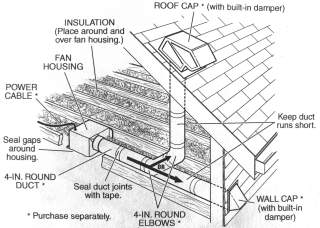 From the fan specs
From the fan specs
"Fan shall have corrosion resistant galvanized steel housing
with four-point mounting capability. It shall be ducted to a
roof or wall cap using 4” round ductwork."
Bottom line: a 4-inch exhaust duct diameter is perfectly permissible and will work fine as long as the CFM rate of the fan OR the length of duct run (including effects of elbows or bends) does not exceed what the manufacturer recommends. In those cases a larger duct may be the solution.
On 2020-06-20 by Chad - Broan AR-110 exhaust vent fan installation manual & specs
[Below at InspectApedia.com are] links to the installation guide and the spec sheet for this model. (the spec sheet also specifies 4" duct).
Thanks for the discussion as well!
- Broan AR-110 BATH EXHAUST FAN INSTALLATION MANUAL [PDF]
- Broan AR-110 BATHROOM EXHAUST FAN SPECIFICATIONS [PDF]
On 2020-06-20 - by (mod) - follow the manufacturer's specs on bath exhaust fan duct size & length limits
Chad
Certainly a manufacturer's instructions are most-important to follow.
I'd like to have a copy of that manual for review, and to see the manufacturer and the age of the product and its information.
Thank you for the helpful discussion.
On 2020-06-20 by Chad
Thanks for the reply. That is what is confusing to me. When I started to research maximum runs for ducting, I stumbled on to this site which has charts that indicate a fan with 100CFM can not use 4" ducting yet the installation manual for this 110 CFM fan never mentions any other ducting other than 4".
[Above] is an image from the manual. These are the only two places where ducting is shown or mentioned. The first is in this picture. The second is literally step 7 of the installation procedure that says "Connect 4 inch Round Duct". That's it.
On 2020-06-19 - by (mod) - do I have to go up to a 6-inch diameter exhaust tube?
Chad
There's no trouble finding an adapter between duct sizes, but we ought to start with a very careful review of the fan manufacturer's installation instructions. Comply with those specs on duct length, elbows, diameter, etc and you'll be ok, including use of a 4-inch duct, as you can also see in the tables above on this page.
In general a 4-inch exhaust fan vent an run
- 25 ft. if using flex duct
- 70 ft. if using smooth metal duct
- with a maximum of 3 elbows
- Table M1507.4 Prescriptive Exhaust Duct Sizing on the page above. Other sources vary slightly from these numbers.
On 2020-06-19 by Chad
I am finally finishing a basement bathroom that was originally roughed in when the house was built 11 years ago.
The size of the room calls for a fan rated at 85CFM. I have purchased a light/fan combo that is 110 CFM. The bathroom is at the front of the house, basically under the front porch, leaving me little options for venting at the nearest exterior wall due to the porch (and a wife who does not particularly care for a vent on the front of the house).
I believe I am going to have to run the vent to the side of the house which is approximately 18-20 feet from vent placement
The fan comes with a connection for 4" vent tube. Am I going to have to use an adapter to go up to 6" tube?
So connect 4" pipe to van, go up to 6" pipe, then go back to 4" at the connection to the exterior louvered cap?
On 2020-05-14 - by (mod) -
PJ
Ask your local code inspector if she will accept your deviation from the loc as k code if you are following the manufacturer's instructions.
Generally a 4 inch flex duct can carry a fan exhaust for up to 25 ft.
Most codes require that.
On 2020-04-22 by P.J. - Fantech not helpful - how do codes apply to flex duct
How do the codes apply to Fantech fans, particularly where Fantech recommends their 4" flexible insulated pipe attached to a 110 CFM fan (the specs show that its max is actually 139 CFM).
I want to connect the vent in the bathroom to about 1 foot of rigid, then one 90 degree rigid elbow, then connect that to about 17' of Fantech's flexible duct (running vertically) before venting to the roof.
The codes here (Salt Lake City, UT - IRC 2015) say that I cannot even hook up a 110 CFM fan to 4" flexible pipe, but Fantech says that is exactly what I should do. I don't want to install the Fantech fan if the inspector is going to tell me it is not permitted.
FWIW, my bathroom has a window, so maybe I can just install it, even if it's not to code? Lastly, I've contacted Fantech, and they are totally unhelpful.
I should add that I only need about 60 CFM if I do the length, width, height calculation method, and the Fantech website says I need 64 CFM but does not provide any explanation for how that is calculated.
On 2020-01-20 - by (mod) - factor in elbows and other restrictions in maximum duct length and minimum duct diameter as well as fan cfm
Anonymous and Curt: just check the total equivalent duct length after you've factored in elbows and other restrictions, to be sure the CFM will be adequate.
On 2020-01-20 by Curt G.
Is This Acceptable? The Powder Room is in the center of the first floor, without access to the exterior walls. However, we can run a 4" foam-core PVC pipe up through an insulated interior wall on the second floor, to the attic.
Once in the attic, we would run a 5' (heavily insulated) duct to an existing un-used roof vent (installed by roofers). The total pipe / duct length is approximately 17', with 3 elbows. The powder room is 25 sq. ft. (200 cu. ft.).
We plan on installing an exhaust fan with 70-80 CFM to quickly exhaust the air and to have a more powerful unit. Any advice, comments, suggestions, or warnings would be greatly appreciated. cjnsg@tds.net
On 2018-08-30 - by (mod) - proper location of exhaust vent fan outlets - code
Anon
4 baths but 3 fans - so I'll just deal with the 3 fans.
3 x 320 cfm = 960 cfm to be vented.
Your inline exhaust fan has to thus be have a 960 CFM capacity before allowing for losses due to duct size, bends, material, restrictions in air flow and duct length.
For that air volume 8" diameter vent ducts are close to their limit and 10" is indeed preferable.
The inline exhaust fan can go anywhere in that length when you figure that the forces it has to overcome include BOTH the losses on the fan's suction or inlet side AND the losses on the fan's outlet side. These are properly-termed resistance to air flow or SP or Static Pressure.
Kitchen and bath exhaust fan manufacturers give duct sizing charts for various air flow requirements, such as this
- EXHAUST DUCT VENT FAN SIZING CHART [PDF] from CaptiveAir Products, 4641 Paragon Park Road
Raleigh, NC 27616 USA Tel: (919) 882-2410
Toll Free: (800) 334-9256 retrieved 2018/08/30 original source: https://www.captiveaire.com/CATALOGCONTENT/DUCTWORK/doc/Duct%20Size%20CAS.pdf?v=3072018
There you'll see that both CFM and actual air velocity have to be considered, so there is no single "right" answer.
Changing duct diameter from the diameter of the fan itself also introduces losses.
Separately there are rules about where the exhaust fan termination is placed:
501.2.1Location of exhaust outlets
The termination point of exhaust outlets and ducts discharging to the outdoors shall be located with the following minimum distances:
1. For ducts conveying explosive or flammable vapors, fumes or dusts:
30 feet (9144 mm) from property lines;10feet(3048mm)from operable openings into buildings; 6 feet (1829 mm) from exterior walls and roofs;
30feet(9144mm)from combustible walls and operable openings into buildings which are in the direction of the exhaust discharge;
10feet(3048mm) above adjoining grade.
2. For other product-conveying outlets:
10 feet (3048 mm) from the property lines;
3 feet (914 mm) from exterior walls and roofs;
10 feet (3048 mm) from operable openings into buildings;
10 feet (3048 mm) above adjoining grade.
3. For environmental air duct exhaust:
3 feet (914 mm) from property lines;
3 feet (914 mm) from operable openings into buildings for all occupancies other than GroupU, and 10 feet (3048mm) from mechanical air intakes.
4. For specific systems:
For clothes dryer exhaust, see Section 504.4;
for kitchen hoods, see Section 506.3;
for dust, stock and conveying systems, see Section 511.2; and
for subslab soil exhaust systems, see Section 512.4.
On 2018-08-30 by Anonymous
I have 4 bathrooms back to back all three fans 320 cfm with an 8 Inch flexible duct attaching to a 10 inch metal duct non flex and runs thirty feet horizontal to the outside and want to install an inline exhaust fan how far from the end does this inline need to be is twelve feet from the end going to be sufficient?
On 2017-04-09 - by (mod) -
Sorry Anil I don't understand the question. Why would a toilet require different venting when located in a pharmaceutical manufacturing plant?
On 2017-04-09 by Anil
What is the recommended formacitical manufacturing industry worker toilet exhuast system details
...
Continue reading at BATHROOM VENT DUCT MATERIALS or select a topic from the closely-related articles below, or see the complete ARTICLE INDEX.
Or see these
Recommended Articles
- BATHROOM VENTILATION CODES SPECS - home
- BATHROOM VENTILATION DESIGN
- BATH KITCHEN VENT DUCT SHARING
- BATHROOM VENT AIR FLOW MEASUREMENT
- BATHROOM VENT AIR SUPPLY
- BATHROOM VENT CLEARANCES
- BATHROOM VENT CODES
- BATHROOM VENT DUCT LENGTHS
- BATHROOM VENT DUCT MATERIALS
- BATHROOM VENT DUCT ROUTING
- BATHROOM VENT DUCT INSULATION
- BATHROOM VENT DUCT SLOPE
- BATHROOM VENT DUCT TERMINATION
- BATHROOM VENT DUCT PROTECTION
- BATHROOM VENT DOWN in CATHEDRAL CEILING
- BATHROOM VENT DOWN THROUGH FLOOR / CRAWL AREA
- BATHROOM VENT UP THROUGH ROOF
- PRYNE VENTILATION FANS CATALOG 1950 [PDF]
- TRADEWIND KITCHEN VENT CATALOG 1950 [PDF]
Suggested citation for this web page
BATHROOM VENT DUCT LENGTHS at InspectApedia.com - online encyclopedia of building & environmental inspection, testing, diagnosis, repair, & problem prevention advice.
Or see this
INDEX to RELATED ARTICLES: ARTICLE INDEX to BUILDING VENTILATION
Or use the SEARCH BOX found below to Ask a Question or Search InspectApedia
Ask a Question or Search InspectApedia
Try the search box just below, or if you prefer, post a question or comment in the Comments box below and we will respond promptly.
Search the InspectApedia website
Note: appearance of your Comment below may be delayed: if your comment contains an image, photograph, web link, or text that looks to the software as if it might be a web link, your posting will appear after it has been approved by a moderator. Apologies for the delay.
Only one image can be added per comment but you can post as many comments, and therefore images, as you like.
You will not receive a notification when a response to your question has been posted.
Please bookmark this page to make it easy for you to check back for our response.
IF above you see "Comment Form is loading comments..." then COMMENT BOX - countable.ca / bawkbox.com IS NOT WORKING.
In any case you are welcome to send an email directly to us at InspectApedia.com at editor@inspectApedia.com
We'll reply to you directly. Please help us help you by noting, in your email, the URL of the InspectApedia page where you wanted to comment.
Citations & References
In addition to any citations in the article above, a full list is available on request.
- "About the House - Bathroom Vents", Henri deMarne, New England Builder, November 1985
- "Bathroom Vent Fan Beats Open Window", James Dulley, Poughkeepsie Journal, 11/4/1987 p. 12D.
- Eric Galow, Galow Homes, Lagrangeville, NY. Mr. Galow can be reached by email: ericgalow@gmail.com or by telephone: 914-474-6613. Mr. Galow specializes in residential construction including both new homes and repairs, renovations, and additions.
- Mark Cramer Inspection Services Mark Cramer, Tampa Florida, Mr. Cramer is a past president of ASHI, the American Society of Home Inspectors and is a Florida home inspector and home inspection educator. Mr. Cramer serves on the ASHI Home Inspection Standards. Contact Mark Cramer at: 727-595-4211 mark@BestTampaInspector.com
- John Cranor [Website: /www.house-whisperer.com ] is an ASHI member and a home inspector (The House Whisperer) is located in Glen Allen, VA 23060. He is also a contributor to InspectApedia.com in several technical areas such as plumbing and appliances (dryer vents). Contact Mr. Cranor at 804-873-8534 or by Email: johncranor@verizon.net
- Eric Galow, Galow Homes, Lagrangeville, NY. Mr. Galow can be reached by email: ericgalow@gmail.com or by telephone: 914-474-6613. Mr. Galow specializes in residential construction including both new homes and repairs, renovations, and additions.
References for Bathroom Vent Fan Installation
- Fantech Installation, Operation, and Maintenance Manual, PB Series Premium Bath Fans. These fan models use a remote fan motor and
are available in 4" duct and 6" duct models. Web search 7/26/11 - original source http://fantech.net/docs-resi/412889-pb-install.pdf
Contact Fantech:
Fantech in the United States 10048 Industrial Blvd., Lenexa, KS 66215 Phone: 800.747.1762; 913.752.6000 Fax: 800.487.9915; 913.752.6466 www.fantech.net; info@fantech.net
Fantech in Canada 50 Kanalflakt Way, Bouctouche, NB E4S 3M5 Phone: 800.565.3548; 506.743.9500 Fax: 877.747.8116; 506.743.9600 www.fantech.ca; info@fantech.ca
- Nutone Bathroom Exhaust Fan/Light Combination Installation Instructions, Model 8663RP, 8673RP, 8664RP suitable for use
in shower or tub enclosure when used with GFCI protected branch circuit. Suitable for use in insulated ceilings.
Nutone, 4820 Red Bank Road, Cincinnati, Ohio 45227, web search 07/27/2011, original source: http://www.nutone.com/PDF/InstallGuides/8663RPins61784.pdf - Our recommended books about building & mechanical systems design, inspection, problem diagnosis, and repair, and about indoor environment and IAQ testing, diagnosis, and cleanup are at the InspectAPedia Bookstore. Also see our Book Reviews - InspectAPedia.
- In addition to citations & references found in this article, see the research citations given at the end of the related articles found at our suggested
CONTINUE READING or RECOMMENDED ARTICLES.
- Carson, Dunlop & Associates Ltd., 120 Carlton Street Suite 407, Toronto ON M5A 4K2. Tel: (416) 964-9415 1-800-268-7070 Email: info@carsondunlop.com. Alan Carson is a past president of ASHI, the American Society of Home Inspectors.
Thanks to Alan Carson and Bob Dunlop, for permission for InspectAPedia to use text excerpts from The HOME REFERENCE BOOK - the Encyclopedia of Homes and to use illustrations from The ILLUSTRATED HOME .
Carson Dunlop Associates provides extensive home inspection education and report writing material. In gratitude we provide links to tsome Carson Dunlop Associates products and services.


